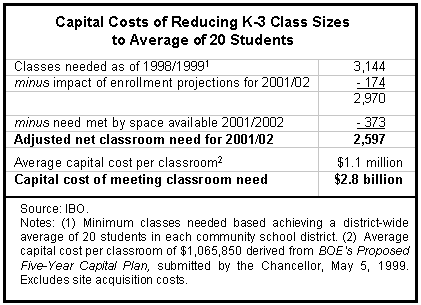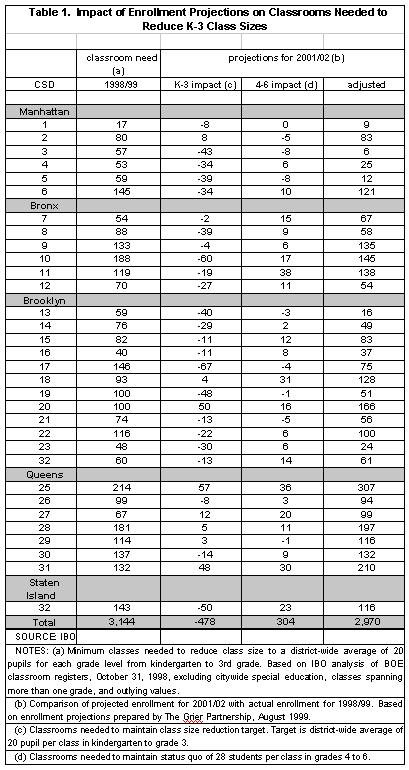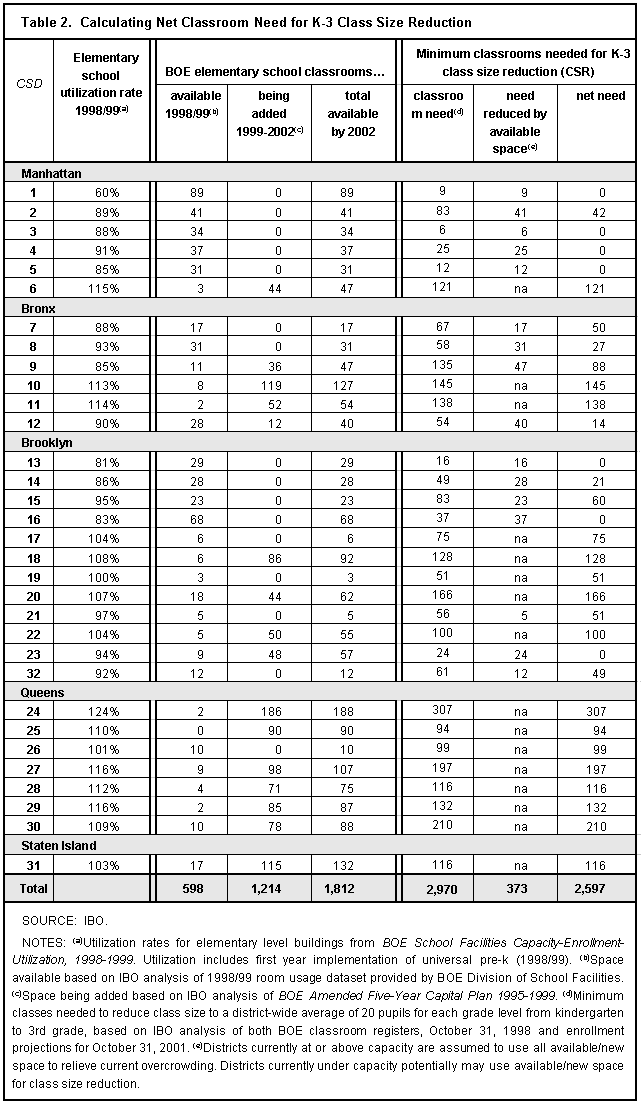During the last school year, more than three-fifths of elementary school children attended schools where enrollment exceeded capacity. These overcrowded schools often have converted their cafeterias, auditoriums, and gymnasiums into makeshift classrooms and in many cases have eliminated cluster rooms for science, art, music, and computers.
BOE has begun lowering class sizes in the current school year. To achieve a 20 student per class average by the 2001/02 school year, IBO estimates that roughly 2,600 additional classrooms will be needed at a cost nearing $2.8 billion.
IBO's estimate is based on our analysis of BOE classroom registers for 1998/99, which found a citywide average of 24.9 students per K-3 class. A minimum of 3,144 additional classes would have been needed in 1998/99 to reduce the average to 20 students per K-3 class in each community school district. However, BOE expects K-3 enrollment to decline by 2001/02, reducing the number of classes needed. This will be partially offset by increased need due to projected enrollment growth in grades 4-6. The net effect of these enrollment changes reduces the number of classes needed for 2001/02 by 174, from 3,144 to 2,970.
Need is reduced further because some of the least crowded schools have excess rooms not currently being used for instruction and new classrooms will be added over the next few years. IBO estimates that BOE school buildings with excess capacity had nearly 600 available classrooms in 1998/99. However, many of these classrooms are located in less populous districts, where they are not needed to reduce class sizes.
Moreover, BOE is planning to add over 1,200 additional classrooms between 1999-2002 through new construction, leasing, building additions, temporary units, and room partitioning. Since most new space is being built in areas that are already overcrowded, it will not be available for new initiatives such as class size reduction. Schools in these areas instead would presumably use new space to reduce crowding by restoring such facilities such as cafeterias, gymnasiums, auditoriums, and cluster rooms to their intended uses. Of the classrooms currently available and newly added, IBO estimates that a total of 373 could be used by 2001/02 for class size reduction, thereby reducing net need from 2,970 classrooms to 2,597.
Creating roughly 2,600 classrooms would cost nearly $2.8 billion. This estimate is based on an average capital cost of $1,065,850 per classroom ($42,634 per seat), excluding site acquisition costs. The estimate reflects the mix of new construction and leasing included in the Chancellor's proposed five-year capital plan for 2000-2004. (Average costs may be less under the adopted five-year capital plan for 2000-2004, due to an increased proportion of leasing projects.)

Estimating class size reduction need. Using classroom registers from October 31, 1998, IBO estimated that 3,144 additional class formations would have been needed at that point in time to reduce early grade (K-3) classes in each community school district (CSD) to an average of 20 students per class (see Table 1). For this analysis, we excluded citywide special education classes, "bridge classes" spanning more than one grade, and outlying values with fewer than five students or more than 50 students. It is important to recognize that achieving a district-wide average class size of 20 students is less ambitious than achieving an average class size of 20 in every school. Reducing class sizes to an average of 20 at the school level would require hundreds of more classrooms. (These class size reduction estimates were previously presented in the IBO report, Implementing Universal Prekindergarten in New York City, November 1999.)
BOE demographers project K-3 enrollments to decline by 9,700 students from 1998/99 to 2001/02. However, they project enrollments in grades 4-6 to climb by 8,400 students. (See "Enrollment Projections 1998 to 2008: New York City Public Schools," August 1999, prepared for BOE by Eunice and George Grier.) Due to the projected enrollment decrease, IBO estimates that 478 less K-3 classes would be needed to reach the target average class size of 20 in 2001/02. This would be partially offset by 304 additional classrooms needed to maintain the current 28 student per class average in grades 4-6. Enrollment changes would thus reduce projected classroom need by 174 in 2001/02 when compared with 1998/99 (from 3,144 to 2,970).
Estimating space potentially available. Table 2 presents IBO estimates of elementary school classrooms potentially available for class size reduction. IBO has analyzed 1998/99 room usage data provided by BOE Division of School Facilities. The dataset includes an inventory of every room in each school building coded by their 1998/99 usage.
IBO has confined its analysis of current room usage to elementary school buildings currently at less than 100 percent capacity. We have assumed that districts and schools at or above 100 percent capacity would use any available rooms to relieve crowding rather than for new initiatives, such as class size reduction. Overcrowded schools often cope with the crush of students by converting their cafeterias, auditoriums, and gymnasiums into makeshift classrooms and/or eliminating cluster rooms for science, art, music, and computers. These schools would presumably use new space to reduce crowding by reclaiming cafeterias, gymnasiums, auditoriums, and cluster rooms. We also have excluded rooms with less than 500 square feet, since BOE uses 500 square feet as a minimum standard for assigning a room instructional capacity.
A total of 598 classrooms were identified as being potentially available to house newly formed classes. These include four types of classrooms: 1) vacant rooms; 2) rooms used by non-instructional organizations; 3) rooms used for administrative purposes exceeding the school's allotment; and 4) parent/teacher rooms exceeding the school's allotment. By using only these four categories, no rooms currently used for instruction were counted as available to house a newly formed class. Of course, many of these potentially available BOE classrooms are located in less populous districts, where they would not be needed to reduce class sizes.
IBO has also analyzed the BOE Amended Five-Year Capital Plan, Fiscal Years 1995-1999, which was released in March 1999 and approved in June 1999. The amended plan updates the status of construction projects in progress. IBO has used the amended plan to tally, by district, 1,214 elementary school classrooms BOE plans to add by the 2001/02 school year. As Table 2 indicates, 1,118 of the 1,214 rooms are being built in districts that are already overcrowded and therefore would not be available for new initiatives such as class size reduction. Of the 16 CSDs with elementary school utilization rates below 100 percent, only Districts 9, 12, and 23 are slated to receive new space. Furthermore, BOE plans for increasing capacity by 2001/02 may be overstated since they do not include seats BOE could lose due to factors such as school closings, lease expirations, and rooms sealed because of hazardous conditions.
IBO estimates that 373 of the classrooms BOE will have available by 2001/02 could be used for class size reduction. As shown in Table 2, usage of these rooms would decrease net need from 2,970 classrooms to 2,597.
Capital costs. Creating roughly 2,600 classrooms would cost $2.8 billion. This estimate is based on an average capital cost of $1,065,850 per classroom (25 seats per room at $42,634 per seat), excluding site acquisition costs. This estimate reflects the mix of new construction and leasing included in the Chancellor's proposed five-year capital plan for 2000-2004. The capital mix includes the construction of 45,850 seats for elementary and middle school grades at $49,243 per seat and leasing 11,850 seats at $17,063 per seat. Because some facilities listed in the proposed capital plan would serve elementary and middle school grades, it was not possible to identify a project mix solely for elementary school grades. BOE Division of School Facilities has not yet provided complete details of the Adopted Five-Year Capital Plan for Fiscal Years 2000-2004. Average costs may be less under the adopted five-year capital plan for 2000-2004 than the proposed plan, due to an increased proportion of leasing projects.
The Board incurs both capital and operating costs when it leases buildings and uses them as schools. BOE spends capital funds to retrofit the buildings and spends operating funds to pay rent to the owners of the buildings. While the above capital cost estimates include retrofitting leased buildings, they do not include the cost of renting the buildings. Primarily due to rent, new leased facilities cost approximately $25,000 per classroom ($1,000 per seat) more per year to operate than newly constructed schools. IBO has analyzed data compiled by the NYC Office of Management and Budget regarding schools leased by BOE. Rent payments for leased facilities cost an estimated $1,184 per seat per year. The added expense of rent is partially offset by reduced custodial costs of $176 to $196 per seat per year.
Other issues. During the current school year (1999-2000), BOE has begun assigning second teachers to large classes in crowded schools where insufficient space exists for new class formations. IBO has not attempted to estimate the impact of this instructional strategy on the need for classroom space.
In the current school year, BOE is implementing new system-wide promotion standards for grades 3-12. Beginning in 2000/01, an increased number of students are expected to be held back. IBO has not attempted to estimate the impact of the new policy on elementary school enrollments and class sizes.
For more information please contact Robert Weiner, a senior budget and policy analyst at IBO, at (212) 442-0332.

